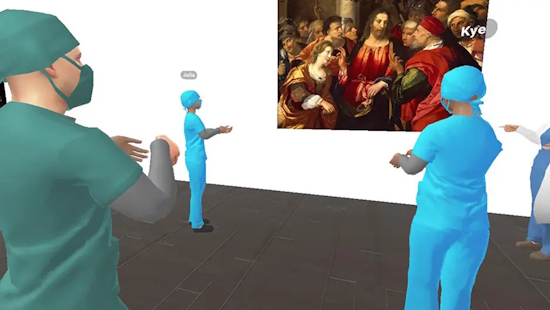[An interdisciplinary team at the University of Miami is studying the effectiveness of visual arts training via presence-evoking virtual reality for teaching medical, nursing and physical therapy students. As one of the researchers notes, “Through guided discussion of art, students learn to embrace multiple perspectives, tolerate ambiguity, and support their interpretations with evidence, which are abilities that translate directly to the bedside.” See the original version of the story for two more images. For a related story about a virtual reality nutrition training program, see a story from New Mexico State University. –Matthew]

[Image: A virtual reality session with six health professions students at the University of Miami that was conducted as part of a 2023 pilot test in collaboration with MediaCombo. Credit: MediaCombo]
Using art and virtual reality to train future health professionals
An interdisciplinary team of researchers is studying the effectiveness of virtual reality visual arts training for medical, nursing, and physical therapy students.
By Kyra Gurney
October 17, 2025
A museum visit to discuss artwork isn’t the first thing that comes to mind when thinking about the training medical, nursing, and physical therapy students receive. But a growing number of health professions schools are incorporating visual arts activities into their curriculum to help students sharpen their observation and communication skills and deepen their empathy.
Now, the University of Miami—in partnership with the creative technology studio MediaCombo—is testing the effectiveness of offering this training through a virtual reality platform.
“We are hoping to evaluate the effectiveness of a virtual reality art gallery environment in learning about the importance of communication, ability to tolerate ambiguity, and interprofessional collaboration in health care practice,” said Christina Larson, assistant director of the Center for the Humanities at the College of Arts and Sciences and one of the co-principal investigators on the study. “Being curious, listening attentively, taking time to assess verbal and nonverbal information, paraphrasing to convey understanding—these are all skills that students will practice in our study that are transferrable to patient-centered care.”
The study was made possible thanks to a $260,000 grant the National Institutes of Health awarded MediaCombo to develop a virtual reality platform for visual arts training. MediaCombo enlisted the help of researchers at the University to assess the effectiveness of the platform, which is called VITaLS: Visual Thinking and Learning Strategies.
“VITaLS addresses a critical health care challenge: the communication and teamwork failures that contribute to an estimated 440,000 preventable deaths annually in the United States,” said Robin White Owen and Michael Owen, the co-founders of MediaCombo. “Our VR platform will scale access to training these essential skills to future health care professionals, regardless of geographic location, to improve patient outcomes.”
At the University, which has long been a national leader in integrating arts and humanities into health care education, the study brings together an interdisciplinary team of collaborators. In addition to Larson from the Center for the Humanities, the other principal investigators are Gauri Agarwal, an associate professor of clinical medicine and associate dean of curriculum at the Miller School of Medicine, and Greta Mitzova-Vladinov, an associate professor of clinical nursing and health studies and director of the Nurse Anesthesia Program at the School of Nursing and Health Studies. The Lowe Art Museum, University of Miami Libraries, and Neva Kirk-Sanchez, a professor of clinical physical therapy and director of the Doctor of Physical Therapy Program at the Miller School, are also involved in the initiative.
In the first phase of the study, medical, nursing, and physical therapy students will participate in three visual arts sessions using the virtual reality platform. The sessions will be facilitated by Hope Torrents, who previously worked as a museum educator at the Lowe. Before and after the sessions, the participants will complete surveys that measure interprofessional learning, tolerance for ambiguity, and communication skills. They will also complete a survey about their experience learning in the virtual reality environment.
The study uses a framework for discussing visual art called Visual Thinking Strategies (VTS). In this approach, students observe works of art and participate in facilitated group discussions about them. Previous studies, including research conducted at the University, have shown that VTS improves empathy, active listening, analytical thinking, and the ability to analyze clinical images, among other important skills for health care providers.
“Visual Thinking Strategies give health professions students a powerful framework for slowing down, observing carefully, and communicating precisely,” Agarwal said. “These are skills that are essential in both clinical reasoning and compassionate care. Through guided discussion of art, students learn to embrace multiple perspectives, tolerate ambiguity, and support their interpretations with evidence, which are abilities that translate directly to the bedside.”
The Lowe Art Museum is sharing artwork from its collection for the study, while University Libraries is providing the virtual reality headsets.
“This award is a testament to the Lowe’s commitment to cross-curricular innovation and collaboration, not only in the humanities but also in STEM disciplines,” said Jill Deupi, the executive director of the museum, which has offered VTS activities to health professions students at the University for the past 15 years through its Fine Art of Health Care program. “We are grateful to be part of this dynamic interdisciplinary team and look forward to advancing UM’s commitment to exemplarity in research and teaching through this exciting project.”
The team involved in the study hopes that developing a virtual reality platform will expand access to VTS activities by offering them not just in museums, but from any location. Following the first phase of the study, the team plans to expand the program to more universities.
Leave a Reply